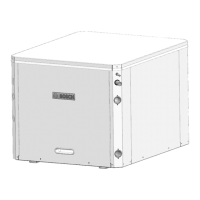Refrigerant Lines | 9LM Split CS Series Heat Pump
8733827906 (2021/11)LM Split CS Series Heat Pump
Subject to change without prior notice
REFRIGERANT LINES
The installation of the copper refrigerant tubing
must be done with care to obtain reliable,
trouble-free operation.
This installation should only be performed by
qualified refrigeration service and installation
personnel.
Refrigerant lines generally must be routed and
supported so as to prevent the transmission of
vibrations into the building structure. Experience
and good design practice dictate 75 feet as the
maximum practical length for interconnecting
refrigerant lines in split system heat pumps
without special considerations.
Beyond 75 feet, system losses become substantial
and the total refrigerant charge required
compromises the reliability and design life of the
equipment.
Copper tubing must be clean and free of moisture
and dirt or debris. The suction and liquid lines
MUST be insulated with at least 3/8” wall, closed-
cell foam rubber insulation or the equivalent.
Some points to consider are:
• Pressure drop (friction losses) in refrigerant
suction lines reduces system capacity and
increases power consumption by as much as
2% or more, depending on the line length,
number of bends, etc. Pressure drop in liquid
lines affects system performance to a lesser
degree, provided that a solid column of liquid
(no flash gas) is being delivered to the
refrigerant metering device, and that the liquid
pressure at the refrigerant metering device is
sufficient to produce the required refrigerant
flow.
• Oil is continually being circulated with the
refrigerant so, oil return to the compressor is
always a consideration in line sizing. Suction
lines on split system heat pumps are also hot
gas lines in the heating mode, but are treated
as suction lines for sizing purposes. If the
recommended suction lines sizes are used,
there should be no problem with oil return.
• Vertical lines should be kept to a minimum.
Vertical liquid lines will have a vertical liquid lift
in either heating or cooling, and the weight of
the liquid head is added to the friction loss to
arrive at the total line pressure drop.
• Wherever possible, the air handler should be
installed at a higher elevation than the
condensing section to aid with oil return to the
compressor.
Linear vs. Equivalent Line Length
Linear Line Length — is the actual measured length
of the line including bends. This is used to
calculate the additional refrigerant charge that
must be added to the system (See Tables #2
through Table #5 for charge adjustments, and
examples).
Equivalent Line Length — is the combination of the
actual length of all the straight runs and the
equivalent length of all bends valves and fittings in
a particular line. The equivalent length of a bend,
valve or fitting is equal to the length of a straight
tube of the same diameter having the same
pressure drop as the particular valve or fitting. The
ASHRAE Fundamentals Handbook provides tables
for determining the equivalent length of various
bends, valves and fittings.
Connecting Refrigerant Lines
• Use only ACR grade copper tubing and keep
ends sealed until joints are made.
• For best performance, select routing of
refrigerant lines for minimum distance and
fewest number of bends.
• Size lines in accordance with Table #2.
• Cut crimped ends off the air handler suction
and liquid lines. Connect and braze lines to the
air handler.
To prevent leaks and possible heat
exchanger fouling, use Teflon tape sealer
when connecting water piping connections
to the unit.
NOTICE: Do not overtighten the
connections.
The air handler is factory supplied with a
holding charge of dry nitrogen.

